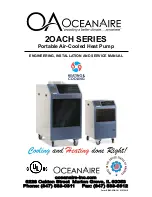
Manual 2100-435F
Page
32 of 40
FIGURE 22
HEAT PUMP CONTROL BOARD (HPC)
DEFROST CYCLE
The defrost cycle is controlled by temperature and time
on the solid state heat pump control. (See Figure 22.)
When the outdoor temperature is in the lower 40°F
temperature range or colder, the outdoor coil
temperature is 32°F or below. This coil temperature is
sensed by the coil sensor mounted near the bottom of
the outdoor coil. Once coil temperature reaches 30°F or
below, the coil sends a signal to the control logic of the
heat pump control and the defrost timer will start.
After 30 minutes at 30°F or below, the heat pump
control will place the system in the defrost mode.
During the defrost mode the refrigerant cycle switches
back to the cooling cycle, the outdoor motor stops,
electric heaters are energized, and hot gas passing
through the outdoor coil melts any accumulated frost.
When the temperature rises to approximately 57°F, the
coil sensor will send a signal to the heat pump control
which will return the system to heating operations
automatically.
If some abnormal or temporary condition such as a high
wind causes the heat pump to have a prolonged defrost
cycle, the heat pump control will restore the system to
heating operation automatically after 10 minutes.
There are three settings on the heat pump control – 30,
60 and 90-minute. Models are shipped wired on the
30-minute setting for greatest operating economy. If
special circumstances require a change to another time,
remove wire connected to terminal 30 and reconnect to
desired terminal. Refer to Figure 22. The
manufacturer’s recommendation is for 30 minute defrost
cycles.
There is a cycle speed up jumper on the control. This can
be used to reduce the time between defrost cycle operation
without waiting for time to elapse.
There is an initial defrost jumper (sen
jmp) on the control that can be used at
any outdoor ambient during the heating
cycle to simulate a 0° coil temperature.
This can be used to check defrost
operation of the unit without waiting for
the outdoor ambient to fall into the
defrost region.
Use a small screwdriver or other
metallic object, or another 1/4 inch QC,
to short between the
SPEEDUP
terminals to accelerate the HPC timer
and initiate defrost. Be careful not to
touch any other terminals with the
instrument used to short the
SPEEDUP
terminals. It may take up to 10 seconds
with the
SPEEDUP
terminals shorted
for the speedup to be completed and the
defrost cycle to start.
As soon as the defrost cycle kicks in
remove the shorting instrument from the SPEEDUP
terminal.
Otherwise the timing will remain accelerated
and run through the 1-minute maximum defrost length
sequence in a matter of seconds and will automatically
terminate the defrost sequence.
There is an initial defrost jumper (sen jmp) on the
control that can be used at any outdoor ambient during
the heating cycle to simulate a 0° coil temperature. This
can be used to check defrost operation of the unit
without waiting for the outdoor ambient to fall into the
defrost region.
By placing a jumper across the
SEN JMP
terminals (a
1/4 inch QC terminal works best) the defrost sensor
mounted on the outdoor coil is shunted out and will
activate the timing circuit. This permits the defrost
cycle to be checked out in warmer weather conditions
without the outdoor temperature having to fall into the
defrost region.
In order to terminate the defrost test the
SEN JMP
jumper must be removed. If left in place too long the
compressor could stop due to the high pressure control
opening because of high pressure condition created by
operating in the cooling mode with outdoor fan off.
Pressure will rise fairly fast as there is likely no actual
frost on the outdoor coil in this artificial test condition.
There is also a 5-minute compressor time delay function
built into the HPC. This is to protect the compressor
from short cycling conditions. In some instances, it is
helpful to the service technician to override or speed up
this timing period, and shorting out the
SPEEDUP
terminals for a few seconds can do this.
Содержание QTEC QH244D
Страница 7: ...Manual 2100 435F Page 7 of 40 FIGURE 1 UNIT DIMENSIONS...
Страница 10: ...Manual 2100 435F Page 10 of 40 FIGURE 6 DUCTEDAPPLICATION FIGURE 5 INSTALLATION WITH FREE BLOW PLENUM...
Страница 26: ...Manual 2100 435F Page 26 of 40 FIGURE 17 FRESH AIR DAMPER REMOVAL MOUNTING SCREW...
Страница 30: ...Manual 2100 435F Page 30 of 40 FIGURE 20 QTEC DEHUMIDIFICATION MODE CIRCUIT DIAGRAM...
Страница 31: ...Manual 2100 435F Page 31 of 40 FIGURE 21 QTEC COOLING MODE CIRCUIT DIAGRAM...









































